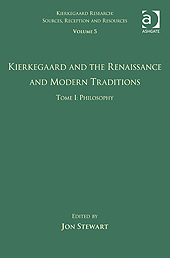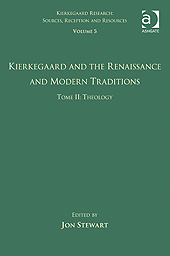The long period from the
Renaissance to the nineteenth century supplied numerous sources
for Kierkegaard’s thought in different fields. The
present, rather heterogeneous volume covers the long period from
the birth of Savonarola in 1452 through the beginning of the
nineteenth century and into Kierkegaard’s own time.
The Danish
thinker read authors representing vastly different traditions
and time periods. Moreover, he also read a diverse range of
genres. His interests concerned not just philosophy, theology
and literature but also drama and music. The present volume
consists of three tomes that are intended to cover Kierkegaard’s
sources in these different fields of thought.
Tome I:
Philosophy
Tome I is dedicated to the
philosophers of the early modern period and the Enlightenment
who played a role in shaping Kierkegaard’s intellectual
development. He was widely read in German and French philosophy
of the sixteenth, seventeenth and eighteenth centuries, making
reference to the leading rationalist philosophers Descartes,
Spinoza and Leibniz in his journals and published works. Further,
connections have also been pointed out between his thought and
the writings of the French thinkers Montaigne, Pascal and
Rousseau, who share with Kierkegaard a form of philosophy that
is more interested in life and existence than purely conceptual
analysis.
Through the works of the authors explored here
Kierkegaard became acquainted with some of the major
philosophical discussions of the modern era such as the
beginning of philosophy, the role of doubt, the status of
autonomy in ethics and religion, human freedom, the problem of theodicy found in thinkers such as Bayle and Leibniz, and
the problem of the relation of philosophy to religion as it
appears in the German writers Jacobi and Lessing.
Table of Contents
Pierre Bayle: Kierkegaard’s Use of the
Historical and
Critical Dictionary
Karl Verstrynge
René Descartes:
Kierkegaard’s Understanding of Doubt and Certainty
Anders Moe Rasmussen
David Hume: Kierkegaard and Hume on Reason, Faith,
and the Ethics of
Philosophy
Thomas Miles
Friedrich Heinrich Jacobi: Two Theories of the Leap
Anders Moe Rasmussen
Gottfried Wilhelm Leibniz: Traces of Kierkegaard’s Reading
of the Theodicy
Arild Waaler and Håvard Løkke
Gotthold Ephraim Lessing: Appropriating the Testimony
of a Theological
Naturalist
Curtis L. Thompson
Michel de
Montaigne: The Vulnerability of Sources in Estimating
Kierkegaard’s Study of
Essais
Søren Landkildehus
Blaise Pascal: Kierkegaard and Pascal as kindred spirits
in the Fight
against
Christendom
Søren Landkildehus
Jean-Jacques Rousseau: Presence and Absence
Vincent A. McCarthy
Baruch de Spinoza: Questioning Transcendence, Teleology and
Truth
Clare Carlisle
Tome II:
Theology
Tome II is
dedicated to the wealth of theological and religious sources
from the beginning of the Reformation to Kierkegaard’s own day.
It examines Kierkegaard’s relations to some of the key figures
of the Reformation period, from the Lutheran, Reformed and
Catholic traditions. It thus explores Kierkegaard’s reception of
theologians and spiritual authors of various denominations, most
of whom are known to history primarily for their exposition of
practical spirituality rather than theological doctrine. Several
of the figures investigated here are connected to the Protestant
tradition of Pietism that Kierkegaard was familiar with from a
very early stage. The main figures in this context include the
“forefather” of Pietism Johann Arndt, the Reformed writer
Gerhard Tersteegen, and the Danish author Hans Adolph Brorson.
With regard to Catholicism, Kierkegaard was familiar with
several popular figures of Catholic humanism, Post-Tridentine
theology and Baroque spirituality, such as François Fénelon,
Ludwig Blosius and Abraham a Sancta Clara. He was also able to
find inspiration in highly controversial and original figures of
the Renaissance and the early Modern period, such as Girolamo
Savonarola or Jacob Böhme, the latter of whom was at the time an
en vogue topic among trendsetting philosophers and theologians
such as Hegel, Franz von Baader, Schelling and Hans Lassen
Martensen.
Table of Contents
Abraham a St. Clara: An Aphoristic Encyclopedia of Christian
Wisdom
Peter Šajda
Johann Arndt: The Pietist Impulse in Kierkegaard and
the Seventeenth-Century Lutheran Devotional Literature
Joseph Ballan
Ludovicus Blosius: A Frightful Satire on Christendom
Peter Šajda
Jacob Böhme: The Ambiguous Legacy of Speculative Passion
Lee C. Barrett
Hans Adolph Brorson: Danish Pietism’s Greatest Hymn Writer and His Relation
to Kierkegaard
Christopher
B. Barnett
John Calvin: Kierkegaard and the Question of the Law’s Third
Use
David Yoon-Jung Kim
Erasmus of Rotterdam: Kierkegaardian Hints at a Christian
Humanist
Finn Gredal Jensen
François de Salignac de la Mothe-Fénelon: Clearing the Way
for
The Sickness
unto Death
Peter Šajda
August Hermann
Francke: Kierkegaard on the Kernel and the Husk of
Pietist Theology
Joseph Ballan
Thomas Hansen Kingo:
An Investigation of the Poet
and Hymnist’s
Impact on Kierkegaard
Christopher B. Barnett
Martin Luther: Reform, Secularization, and the Question of
His “True Successor”
Joel D.S. Ramussen and David Yoon-Jung Kim
Hieronimus Savonarola: Kierkegaard’s Model for the
Blood-Witness
Ivan Sørensen
Gerhard Tersteegen: Kierkegaard’s Reception of a Man of
“Noble Piety and
Simple Wisdom”
Christopher Barnett
Tome III:
Literature, Drama and Music
Tome III covers the sources that are relevant for literature,
drama and music. Kierkegaard was well read in the European
literature of the seventeen and eighteenth century. He was
captivated by the figure of Cervantes’ Don Quixote, who is used
as a model for humor and irony. He also enjoyed French
literature, represented here by articles on Chateaubriand,
Lamartine, and Mérimée. French dramatists were popular on the
Danish stage, and Kierkegaard demonstrated an interest in, among
others, Moliére and Scribe.
Although Kierkegaard never possessed strong
English skills, this did not prevent him from familiarizing
himself with English literature, primarily with the help of
German translations. While there is an established body of
secondary material on Kierkegaard’s relation to Shakespeare,
little has been said about his use of the Irish dramatist
Sheridan. It is obvious from, among other things, The Concept of
Irony that Kierkegaard knew in detail the works of some of the
main writers of the German Romantic movement.
However, his use
of the leading figures of the British Romantic movement, Byron
and Shelley, remains largely unexplored terrain.
The classic
Danish authors of the eighteenth century, Holberg, Wessel and
Ewald, were influential figures who prepared the way for the
Golden Age of Danish poetry. Kierkegaard constantly refers to
their dramatic characters, whom he often employs to illustrate a
philosophical idea with a pregnant example or turn of phrase.
Finally, while Kierkegaard is not an obvious name in musicology,
his analysis of Mozart’s Don Giovanni shows that he had a keen
interest in music on many different levels.
Table of Contents
Lord George Gordon Byron: Seduction, Defiance and Despair:
Lord Byron in the Works of
Kierkegaard
Bartholomew Ryan
Miguel de Cervantes: The Valuable Contribution of a Minor
Influence
Óscar Parcero Oubiña
François-René de Chateaubriand: The Eloquent “Fellowship
of
the Dead”
Ingrid Basso
Johannes Ewald: Poetic Fire
Kim Ravn
Ludvig Holberg: Kierkegaard’s Unacknowledged Mentor
Julie Allen
Alphonse de Lamartine: The Movement “en masse” versus
the Individual Choice
Ingrid Basso
Prosper Mérimée: A New Don Juan
Nataliya Vorobyova
Molière: An Existential Vision of Authenticity in Man Across
Time
Jeanette Bresson Ladegaard Knox
Wolfgang Amadeus Mozart: The Love for Music and the Music of
Love
Elisabete M. de Sousa
Eugène Scribe: The Unfortunate Authorship of a Successful
Author
Elisabete M. de Sousa
William Shakespeare: Kierkegaard’s Post-Romantic Reception
of “the Poet’s
Poet”
Joel D. S. Rasmussen
Percy Bysshe Shelley: Anxious Journeys, the Demonic, and
“Breaking the Silence”
Bartholomew Ryan
Richard Brinsley
Sheridan: A Story of One Review—
Kierkegaard on The School for Scandal
Nataliya Vorobyova
Johan Herman Wessel: Kierkegaard’s Use of Wessel, or the
Crazier the Better
Tonny Aagaard Olesen
Edward Young: Kierkegaard’s Encounter with a Proto-Romantic
Religious Poet
Joseph Ballan















